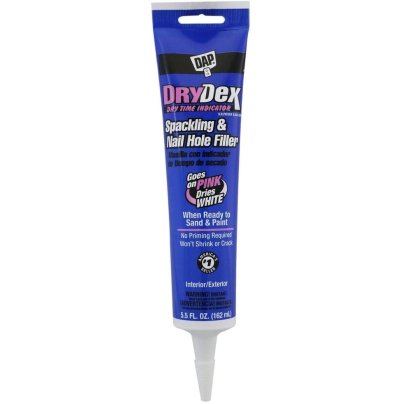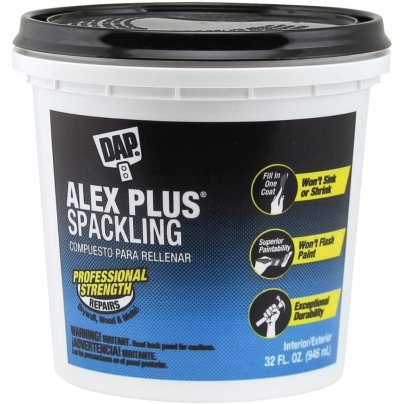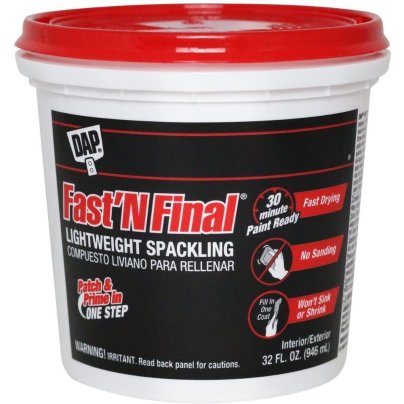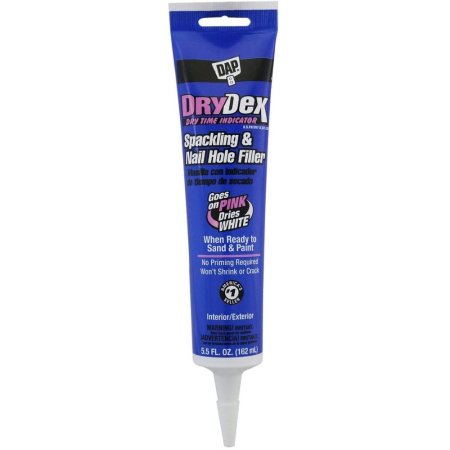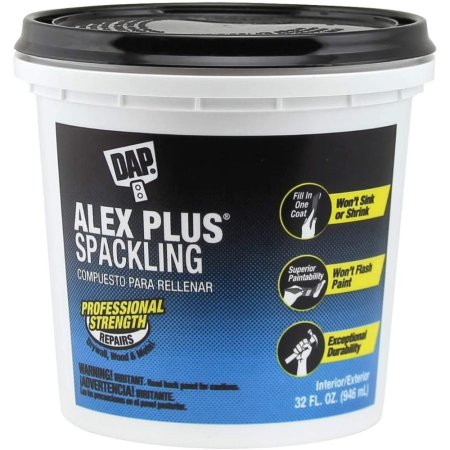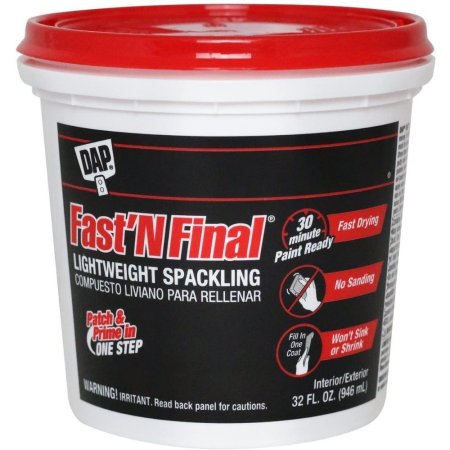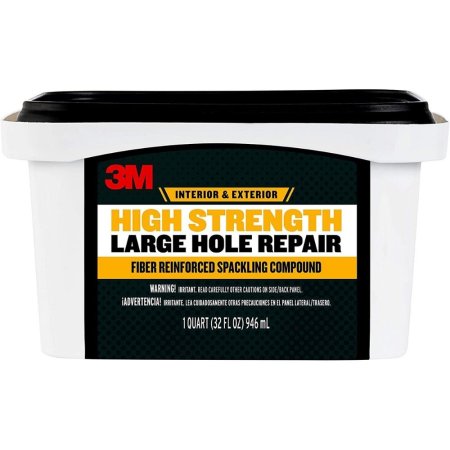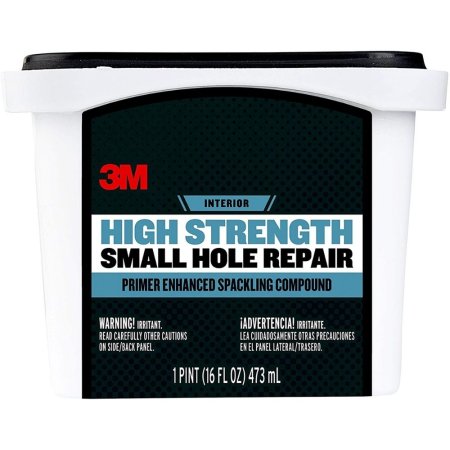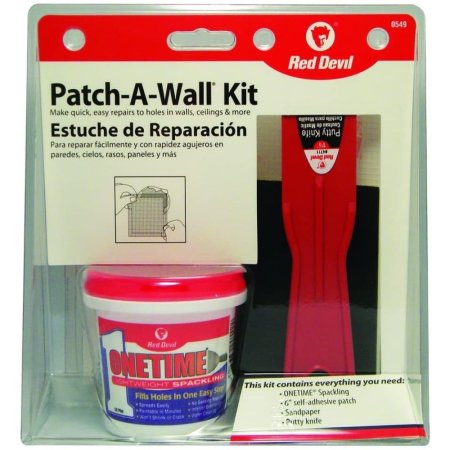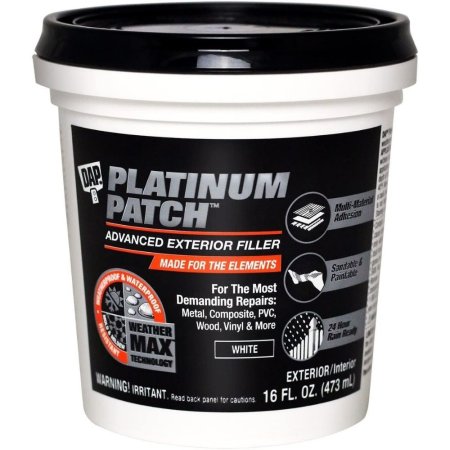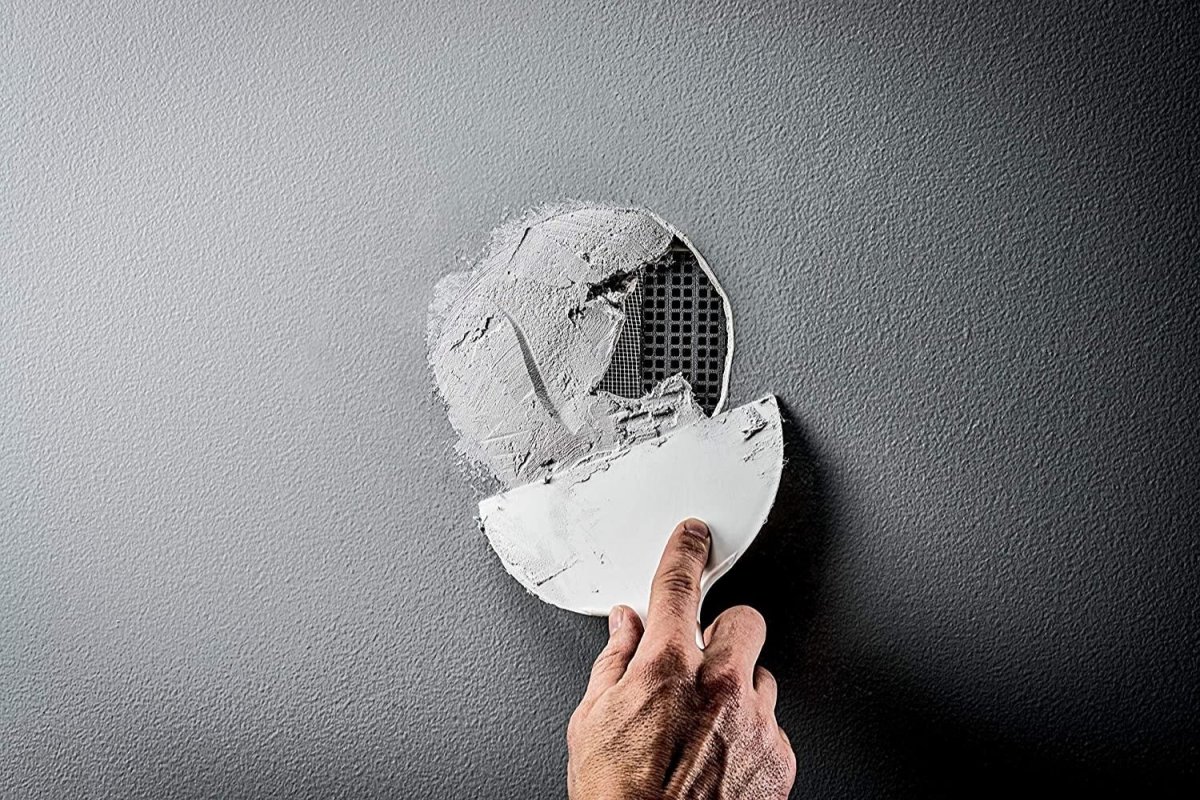
We may earn revenue from the products available on this page and participate in affiliate programs. Learn More ›
The strongest walls in a home will inevitably take a beating over the years, leaving pinholes, gashes, and rough scuffs. While repairing a hole in a wall may seem like a daunting job, it’s one of the easier DIY repairs if one uses the right spackle.
Spackle is a putty with a toothpaste-like consistency that can fill everything from a nail hole to a 6-inch-wide crater when used with a mesh patch. Drying in as little as 30 minutes, spackle makes wall and ceiling repairs a fairly quick job. Read on for more info about spackle and the best spackle choices on the market.
- BEST OVERALL: DAP DryDex Dry Time Indicator Spackling Paste
- BEST VALUE: DAP 18746 Alex Plus Spackling
- BEST FOR NAIL HOLES: DAP 12142, 32.0 Fl Oz, White
- BEST FOR LARGE HOLES: 3M High Strength Large Hole Repair
- BEST FOR FAST PATCHES: 3M High Strength Small Hole Repair
- BEST REPAIR KIT: Red Devil 0549 Lightweight Spackling Patch-A-Wall Kit
- BEST FOR EXTERIOR: DAP 18741 Platinum Patch Filler
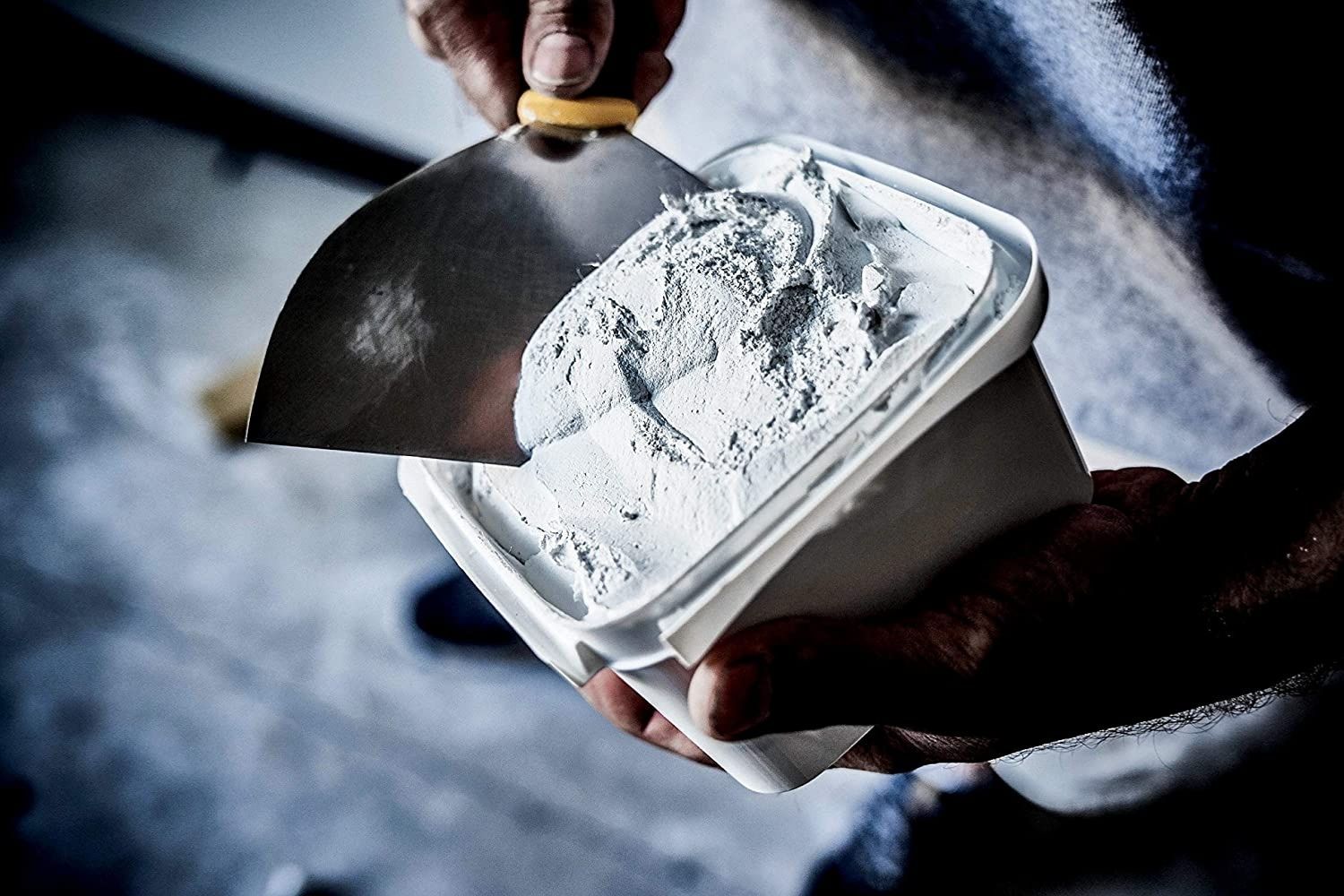
What to Consider When Choosing the Best Spackle
There are a few things to consider when choosing the best spackle for a repair job, including texture, drying time, flexibility, and which type of spackling compound is best suited to tackle which repairs.
Types of Spackling Compound
Understanding the different types of spackles on the market is key to selecting the right spackle for the job. Spackle comes in lightweight, standard, vinyl, epoxy, and acrylic varieties.
- Lightweight: Lightweight spackling compound uses a mix of sodium silicate with an adhesive. Lightweight spackle dries quickly and evenly with little shrinkage, sands easily, and usually only requires a single coat. It’s ideal for patching small nail holes and dents in walls before painting.
- Standard: Standard spackling compounds use gypsum in their formula, which is the same material used in drywall. This makes it ideal for repairing more extensive damage to walls, including holes an inch in diameter or larger. Standard spackling compound also dries to a harder finish capable of withstanding impacts better than lightweight spackle.
- Vinyl: Unlike other compounds, which can typically repair damage in one layer, vinyl is generally applied in multiple layers, with each layer allowed to dry between applications. This makes it ideal for repairing deeper holes and gashes. This type of spackling compound contains elastic polymers that give it excellent strength, making it suitable for interior or exterior use.
- Epoxy: Epoxy is one of the most durable spackle options, but it’s also more complicated to use. Like epoxy adhesives, epoxy spackle comes in two separate bottles—a resin and a hardener—which one must mix just before use. Epoxy is also oil based, which gives it water-resistant qualities that make it better suited than other spackles for outdoor applications.
- Acrylic: Like vinyl, acrylic is ideal for bigger holes and gouges on the interior or exterior of the home. It’s flexible, making it suitable for repairs to drywall, brick, wood, plaster, and even stone. It does not shrink or crack as it dries and can be applied in layers to handle damage up to ¾ of an inch thick.
Size of a Repairing Area
Different spackles are capable of covering different size holes and gashes. While not all manufacturers list the size of the repair the spackle can handle, knowing the type of spackle will give a good indication of what kinds of repairs it will cover. This is crucial to ensuring that the repair holds up once the spackle is dry.
While lightweight spackles are best suited to small nail holes and gouges of ¼ inch or less, standard spackles and heavier spackling compounds can cover gaps and depths of up to ¾ inch. Filling these larger holes usually requires the user to apply a series of layers, allowing each layer to dry between applications.
Larger holes of an inch or more in diameter require the use of a mesh patch. Standard and vinyl spackles are best suited for this type of repair.
Texture
Spackle comes in two types of finishes: textured and smooth. Choose a texture that best matches the material of the wall. Drywall spackle will dry to a rougher textured finish that blends better with the drywall surface once the repair and painting are complete. Spackles designed for plaster, in comparison, will have a smoother finish that matches the texture of plaster walls.
Drying Time
Drying time is an essential aspect of spackling, as it typically precedes a paint job. Spackles with quick dry times allow the user to get on to the main job of painting sooner. Lightweight spackles typically have shorter dry times, with many ready to receive paint just 30 minutes after application. Some lightweight spackles turn from pink to white as they dry, making it easier to identify when the spackle is ready for sanding and painting.
Heavier vinyl and acrylic spackles, by comparison, can take from 1 to 5 hours to dry, depending on how thick the repair is. Keep in mind that temperature and humidity can affect the drying process. Humid conditions and temperatures below 40 degrees will extend the necessary drying time.
Flexibility
Flexibility is a crucial characteristic of spackling, depending on the type of material the spackle is covering. Drywall spackle is typically not as flexible as vinyl and acrylic spackle types that are designed for masonry. Drywall is a stable surface that is not affected by changing temperatures, whereas brick, concrete, and other masonry expand and contract with temperature changes. The spackle must be able to expand and contract with those surfaces to prevent cracking and chipping.
Primer
Once dry, spackle is porous, causing it to suck up the moisture in paint, which may hurt the paint’s ability to cover. With this in mind, one should prime spackle before painting it. For water-based spackles, use a water-based primer. Likewise, oil-based spackles like epoxy require an oil-based primer. Some spackles come with primer mixed in with it. This type of spackle is ready to receive paint as soon as it dries, eliminating the need to prime it before painting it. Some spackles don’t even require sanding.
Our Top Picks
The list below includes spackles with fast drying times for minor prepainting repairs and heavy-duty compounds that are well suited for repairing larger holes and gashes. Any of the spackle products below are effective for making repairs to walls and ceilings.
Best Overall
DAP DryDex Dry Time Indicator Spackling Paste
Pros
- Applies pink and dries white
- Suitable for sanding
- Suitable for indoor and outdoor use
- No priming required
Cons
- Not suitable for use on concrete, vinyl, stucco, or plastic
- Small quantity provided
Product Specs
- Type: Latex
- Repairs: Small and large cracks and holes
- Texture: Smooth
- Drying Time: 10 to 15 minutes
With a versatile formula and a color-changing quality that makes it easy to tell when it’s dry, this product is one of the best all-around spackles on the market. DryDex can cover everything from small nail holes to large gashes that require a mesh patch. While determining when some spackles are dry can be a challenge, DryDex makes it easy: It’s pink when applied and turns to a solid white when dry.
DryDex also won’t shrink or crack, reducing the number of coats needed to complete the job. Once white, it sands easily. And with primer integrated into the spackling, there’s no need to prime before painting over it. DryDex, which comes in ½-pint, 5-ounce, and quart-size containers, is suitable for use on drywall, plaster, and wood, making it an excellent spackle to have on hand for repairs in a pinch.
Get the DAP DryDex spackle at Walmart, The Home Depot, and Lowe’s.
Best Value
DAP 18746 Alex Plus Spackling
Pros
- Professional strength
- Does not shrink or sink
- Suitable for use indoors and outdoors
- Paintable and sandable
Cons
- Takes some time to dry
- May not be the best choice for large cracks and holes
Product Specs
- Type: Latex
- Repairs: Small to large cracks and holes
- Texture: Smooth
- Drying Time: 1 to 5 hours
With its 32-ounce bucket, this spackle offers the same high level of quality as other DAP products at a very similar price, making it an ideal pick for larger wall-repair jobs. This standard spackling compound is versatile with its ability to fill small nail holes or larger cracks and holes.
It dries within a few hours, depending on the thickness of the repair, and is suitable for use with various materials, including drywall, wood, masonry, and metal. With its resistance to cracking and shrinking, it requires a single application for repairs of ¼ inch or less. It can also fill holes of up to ¾ inch when layered.
Get the DAP Alex Plus spackle at Amazon, The Home Depot, and Walmart.
Best for Nail Holes
DAP 12142, 32.0 Fl Oz, White
Pros
- No sanding or priming required
- Suitable for minor repairs
- Does not shrink or crack
- Comes in multiple sizes
Cons
- Takes a long time to completely dry
- Not suitable for large projects and holes
Product Specs
- Type: Lightweight
- Repairs: Small holes and cracks
- Texture: Smooth
- Drying Time: 30 minutes
No one wants to wait an hour or more for that spackled nail hole from the picture hanger to dry so the painting project can get underway. This DAP Fast’N Final Lightweight Spackling is ideal for such minor prepainting repairs. It goes on quickly with a putty knife and is ready for paint in just 30 minutes.
With no sanding or priming required, this spackle is one of the fastest ways to get those minor wall repairs done so the painting can begin. This spackle dries to a hard finish and won’t shrink or crack. DAP Fast’N Final comes in a variety of sizes, including a small 8-ounce unit that’s easy to grip in one hand while applying it with a putty knife in the other.
Get the DAP 12142 spackle at Amazon, Walmart, and Lowe’s.
Best for Large Holes
3M High Strength Large Hole Repair
Pros
- High-strength formula
- Suitable for sanding
- Dries quickly
- Suitable for indoor and outdoor use
Cons
- Pricey compared to similar products
Product Specs
- Type: Acrylic
- Repairs: Large holes and cracks
- Texture: Smooth
- Drying Time: 18 to 30 minutes
More extensive wall and ceiling repairs require a spackle with a heavier consistency. This high-strength spackle from 3M uses fibers in its mix to create a thicker compound that is capable of patching holes between 3 and 5 inches in diameter. Those fibers also give it exceptional strength, enabling this spackle to hold its shape through the drying process while also ensuring a strong patch that will hold up to daily wear and tear once dry.
Its thicker consistency also makes it ideal for sanding. With a dry time as short as 30 minutes, depending on thickness, this spackle dries five times faster than other vinyl spackles. It’s suitable for outdoor use when sealed with paint and works on drywall, plaster, stucco, concrete, and wood.
Get the 3M hole repair at Amazon, The Home Depot, and Walmart.
Best for Fast Patches
3M High Strength Small Hole Repair
Pros
- Easy to apply; only requires one coat
- Dries quickly
- Built-in primer
- Comes in multiple sizes
Cons
- Includes harsh chemicals
Product Specs
- Type: Acrylic
- Repairs: Large holes and cracks
- Texture: Smooth
- Drying Time: 30 minutes
A fast drying time, convenient packaging, and an easy-to-apply formula make this spackle from 3M an ideal option for making quick wall repairs. It’s suitable for repairing holes up to 3 inches in diameter and dries in under an hour. It also resists shrinking, cracking, and sagging, eliminating the need for multiple coats in most cases. And it has a primer mixed into the compound, so it’s ready for painting immediately after it dries.
The spackling comes in a small tub that one can comfortably grip in one hand, convenient for making quick repairs on walls and ceilings. It dries in as little as 30 minutes to a hard finish that’s tough enough to hold screws and nails. 3M High Strength Small Hole Repair comes in 8-, 16-, and 32-ounce containers.
Get the 3M small hole repair at Amazon, The Home Depot, and Lowe’s.
Best Repair Kit
Red Devil 0549 Lightweight Spackling Patch-A-Wall Kit
Pros
- Putty knife, patch, and sandpaper included
- Will not shrink or crack
- Suitable for interior and exterior use
- Affordable price point
Cons
- May not be suitable for large cracks and holes
Product Specs
- Type: Lightweight
- Repairs: Medium and small holes and cracks
- Texture: Smooth
- Drying Time: 1 hour
While most spackling repair kits come with spackling and patches, this four-piece lightweight spackling kit goes the extra mile by also including a putty knife and sandpaper. With all the necessary tools for repairing walls and ceilings, this kit is ideal for anyone who needs to fix damaged walls or ceilings in smaller houses and apartments, but who may not have a workshop with a collection of tools and supplies at the ready.
This kit includes a 6-inch by 6-inch patch for repairing larger holes, a putty knife for easy application of the compound, and a piece of 220-grit sandpaper for sanding the repair to a smooth finish once dry. With a quick drying time of about an hour, this spackle kit is ideal for fast repairs.
Get the Red Devil spackle on Amazon and at Walmart.
Best for Exterior
DAP 18741 Platinum Patch Filler
Pros
- Suitable for use on ample materials
- Waterproof while drying
- Weatherproof and UV-resistant
Cons
- Pricey compared to similar products
- Takes some time to dry
Product Specs
- Type: Standard
- Repairs: Small to large holes and cracks
- Texture: Smooth
- Drying Time: 2 to 4 hours
This spackling dries to a waterproof solid and is compatible with various building materials, making it an excellent option for outdoor repairs. Whereas other exterior spackles require a coating of paint for protection, DAP Platinum is fully waterproof 24 hours after application. It resists mold and mildew growth as well as the damaging UV rays of the sun.
With its ability to adhere to metal, PVC, wood, masonry, vinyl, and virtually any other material found on a home’s exterior, this vinyl is an excellent option for various exterior repairs. DAP Platinum is also easy to conceal once the repair is dry, thanks to its sandable and paintable finish. It comes in a 16-ounce tub.
Get the DAP Platinum Patch spackle at Amazon, The Home Depot, and Walmart.
Our Verdict
For a reliable, long-lasting option, the latex-based DAP spackle can be used to repair large or small holes, used inside and outside, and dries in over 15 minutes. Alternatively, for a heavy-duty solution to large holes and cracks, the acrylic-based 3M hole repair can be sanded after drying and is also usable indoors and outdoors.
How We Chose the Best Spackle
We researched the most sought-after spackling products and discovered that the best options are determined by their type, suitability for large and small cracks and holes, application texture, ease of application and drying time, compatibility with multiple surfaces, and other special features included by select brands.
While searching for the best spackle available, the most popular type among users was the smooth-textured latex, lightweight, acrylic, and standard options for their non-sticking and non-shrinking formulas, quick drying times, and ease of application. While some options are suitable for small cracks and holes, many can fill holes and cracks of up to 6 inches.
Many of the spackle products above are easy to apply with a putty knife and dry within 10 minutes to 5 hours. Plus, some picks come with sandpaper, a putty knife, and patches, have primer integrated, and can be used indoors and outdoors.
Tips for Using Spackle
Spackling a wall without knowing what you are doing can make the crack or hole you are trying to fix even worse and harder to fix. To ensure you are doing the job right, always make sure that you read any special instructions included by the brand ahead of time. Also, make sure that the spackle you are using is suitable for the crack or hole you are repairing as well as the material you are planning to apply spackle to.
Before you start spackling, ensure that you prepare the area by cleaning it and removing loose debris. Then, use slightly angled, downward strokes with your putty knife as you apply the spackle and wipe away any excess product as you go. Once you have filled in the crack or hole completely, allow the area to dry and apply more spackle if necessary. If, after the second coat, you are still not satisfied with the spackle, lightly sand the area then apply paint.
- Before you begin using your spackle, ensure that loose debris, drywall, or other materials are wiped away with a cloth, removed with tools, or sanded to ensure the application is smooth.
- Fine-grit sandpaper or a light-duty sander is suitable for smoothing down the area after drywall spackle is applied.
- After spackling, it may be necessary to pain the entire wall over again to ensure the texture is consistent.
FAQs
For those still wondering about how spackle works, read on for answers to some of the most common questions about this wall- and ceiling-repair product.
Q: Can spackle cause health problems?
As long as it isn’t inhaled in large amounts, spackle is generally not harmful. That said, it’s still important to wear a mask when sanding spackle, as inhaling the dust particles can irritate the throat and airway.
Q: Can water ruin a spackle patch?
Water can ruin a spackle patch when it is bare and unpainted, unless it is a waterproof spackle patch. If working outdoors, make sure to check the weather to ensure it doesn’t rain before the patch has had a chance to dry and receive a coat or two of exterior paint.
Q: Can I use a spackle instead of a joint compound?
Use a joint compound in place of spackle in a pinch, but don’t use spackle for projects that require a joint compound. Spackle is drier and more paste-like than a joint compound, making it an unsuitable replacement.
Q: What is the average drying time for spackle?
While lightweight spackle can dry in as little as 30 minutes, most spackle takes between 1 and 2 hours to dry. Some dry times may be longer or shorter, depending on the thickness of the spackle.
Q: Can I sand spackle?
Yes. In fact, in most cases, sanding the spackle after it’s dry is necessary to ensure it is level with the surface of the wall or ceiling.
Q: Do I need to prime spackle before painting?
While priming minor nail-hole repairs is unnecessary, larger repair jobs require a coat of primer before painting. Spackle is very porous, which can cause it to suck the moisture out of the paint, resulting in inadequate coverage that causes the repaired area to show through the paint. Unless the spackle comes combined with primer, prime the surface before painting it.
Q: Can I save leftover spackle for later?
Yes, but make sure to store it properly. Spackle will dry very quickly when exposed to air and heat, so be sure to seal the lid tightly immediately after use. Store the spackle in a cool place, such as a basement, and never leave the container in direct sunlight.
